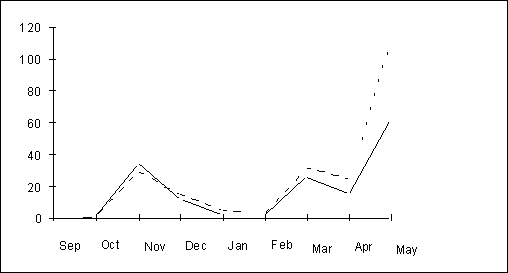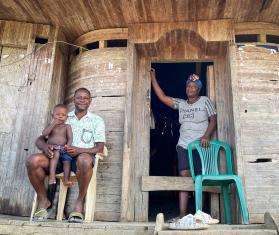Delivered by Marcel van Soest, MSF Epidemiologist
Delivered by Marcel van Soest, MSF EpidemiologistO
n behalf of Doctors Without Borders, I am very grateful for the opportunity to attend this hearing and to give testimony on the crisis in Central Africa.Doctors Without Borders, or Médecins Sans Frontières (MSF), as it is also known, is the world's largest independent international voluntary medical organization. Since 1971, Doctors Without Borders has been providing humanitarian and medical assistance worldwide, and since 1985 has been working with local, displaced and refugee populations in Central Africa.
Today we would like to highlight once more the key humanitarian issues in Central Africa, and express our concerns about responses provided by the U.S. Administration to developments in the region. In the eyes of humanitarian organizations working in the region, the U.S. has appeared as having no clear policy, with significant effects on the population. None of this could be explained by lack of information, as Doctors Without Borders and other organizations have systematically provided local authorities and the US government with early warning signals and evidence of crises in the region.
Your initiative to convene a hearing on this subject has renewed our hope that joint efforts by Congress and the Administration to take an accurate reading of developments in the region will provide the needed leadership to break the cycle of violence, to restore peace and security, and first and foremost to ensure the protection of civilian populations.
HUMANITARIAN CONCERNS IN THE REGION: A KEY RESOURCE FOR U.S. POLICY DECISIONS
We are convinced that the floor today is very much aware of the historical background of the events which threw this region into turmoil in the last few years, dramatically anchored in the Rwandan genocide of April 1994. In 1994, Doctors Without Borders, present in Rwandan hospitals at the height of the massacres, denounced the genocide and the subsequent withdrawal of 1,500 peacekeepers—the sole response of the international community. A few months later, in July 1994, when more than 1 million refugees fled to Zaire and Tanzania, the international community engaged in a large humanitarian assistance program that addressed refugees' basic food and health needs, but not their acute need for protection. As militia members and former members of the Rwandan army re-armed themselves from within the camps, cries for action by humanitarian agencies to isolate the perpetrators of the genocide and bring them to justice fell on deaf ears. Consequently the refugees became hostage and relief workers found themselves aiding and abetting the genociders.
This unaddressed impunity provided a fertile breeding ground for more violence. By documenting the control of the camps by militia leaders and deciding to withdraw our aid from them later that year, our organization provided the impetus for the withdrawal of other relief organizations and for the subsequent revision of US policy with regard to its support for the camps.
Confronted this past year with severe impediments to providing assistance to both local and refugee populations in areas of the Democratic Republic of Congo (Congo) and in Rwanda, we have also been very vocal in expressing our concerns about security and protection of civilians, especially in the light of:
- attacks on civilians in Congo, which prompted the UN Human Rights Commission investigations,
- attacks on civilians and relief workers in Rwanda and Burundi,
- severe restriction of movement imposed on relief teams in eastern Congo and western Rwanda,
- and even the recent announcement of an imminent expulsion of the UNHCR from Goma.
I need not repeat—since it was stated in this forum in a previous hearing—the damaging impact of statements by the U.S. representative in Kigali almost one year ago denying the existence of more than 300,000 refugees fleeing westward from the Rwandan refugee camps under attack. In our "Forced Flight," our report of May 16, 1997, we documented the fate of the refugee groups trekking across the Congo and shed some light on the complex situation in the North-Kivu/Masisi area. The latter has been a site of ongoing ethnic violence since 1993, still provoking attacks on and displacement of the local Congolese population.
As a medical organization, Doctors Without Borders believes that all humanitarian efforts should be aimed at stabilizing the health status of populations so as to reduce mortality and minimize risk for diseases and epidemics. Since November 1996, despite numerous appeals to the parties to the conflict, to the UN, and to the U.S. Administration which maintain de facto foreign diplomatic leadership in the region, our teams have been prevented from having continued access to the refugee and local populations in need and in danger.
Mortality and morbidity surveillance carried out in Tingi Tingi, Kisangani, and Mbandaka—in three periods during which the ADFL did not exceptionally deny us access—and retrospective mortality surveys carried out more recently among refugee groups that reached Congo Republic, provide striking patterns of mortality linked to access status.
Doctors Without Borders conducted a retrospective mortality survey among a group of refugees last July in a refugee camp in Congo Republic ("Epidemiological Survey of Rwandan Refugees in Ndjoundou Camp, Congo, July 1997"). Those refugees had fled the attacked camps in Kivu Province and had undertaken a forced march over a distance of some 1,500 km under the control of elements from the old Rwandan army (FAR) and various militia men. The study was conducted through individual interviews of a random sample of refugees and reconstructed the size and history of the original group.
The survey shows that, of every 5 people from the original group who left the Kivu camps in October 1996, only 1 arrived in Congo Republic; one did not survive repeated military actions; and 3 could not be accounted for. Of those reported killed, 95% were the result of violence, and 5% died from disease.
These figures cannot be extrapolated to all of the refugee population, particularly because the group contained especially high numbers of armed former militia members. Yet it is interesting to note that the proportion of deaths was the same for children under age five as for the entire population, and 41% of deaths by attack were of women. Theses figures also confirm the experience of our field teams, who in May 1997 reported on attacks on refugee camps in areas where this group and other refugee groups had briefly settled, the presence of mass graves in these areas, and "catastrophic" rates of mortality from disease and malnutrition ("Forced Flight").
Monthly mortality rates (crude and under five), September 1996 to May 1997
Rwandan Refugees surveyed in Ndjoundou camp, Brazzaville
Mortality rate per 10,000 persons per day

———— Crude mortality rates - - - - - Under five mortality rates
The above graph shows that peak mortality rates in the refugee population in November 1996 (in Kivu camps), March 1997 (south of Kisangani), and May 1997 (Mbandaka region) correspond exactly to the periods when relief workers were denied access to populations in danger. Importantly, mortality cases from violence outnumber (by a proportion of 95% to 5%) cases linked to malnutrition and illness.
More details are available in the report. However, the point is this: the mortality rates (crude and under age five) of the surveyed population from October 1996 through May 1997 show that when humanitarian organizations did not have access, deaths—primarily by violence—dramatically increased.
These statistics confirm the experience of our field teams, who, at the end of April 1997, reported in attacks on refugee camps in areas where this group and other refugee groups had briefly settled, the presence of mass graves in these areas, and "catastrophic" rates of mortality from disease and malnutrition.
HUMANITARIAN ACCESS: AN EARLY-WARNING INDICATOR
It is our firm belief that one of your first recommendations to the Administration should be to make use of our presence in the region, and the degree of access and flexibility of movement generally offered to relief organizations, as an early-warning indicator of humanitarian conditions. Of course we, relief workers, cannot protect populations from genocides or massacres: that was amply proved in April 1994. But lack of access and other obstacles to providing assistance are signals of serious developments in the region.
Whenever such access problems occur, Washington ought to act immediately and decisively through diplomatic channels. This action would spare the embarrassment, months after the fact, of having to impose human-rights abuse investigations on actors that the Administration fully supported while the abuses occurred. It could also spare thousands of lives.
If, as is our impression, the U.S. is now embarrassed by the need for a post mortem investigation of human rights abuses in the region, it has one resource that could help it in the future: the voices of humanitarian actors, when they request that regional, national, and international political powers in the Great Lakes area provide access and security, and engage in diplomatic efforts promptly to resolve local crises at an early stage.
Should you want to use this resource right away, you should be aware that relief teams have no problem with access in most regions of the Democratic Republic of Congo, where we are continuing and expanding our standard medical assistance programs. But in eastern Congo, we are quite concerned about the recent threat of expulsion presented to the UNHCR; the fighting that continues in north and south Kivu involving the Hutu, Hunde, Mai Mai, Banyamulenge, Bandarwanda, and troops of the ADFL; and the displacement of tens of thousands of local residents. The authorities have allowed our access to these parts, but due to insecurity, access is still limited.
If this framework can be extended to policy issues throughout the region, I should like to bring your attention to western Rwanda, which is in a state of war, with a heavy toll on civilians, and almost completely off limits to staff from international organizations.
While the U.S. government continues to follow the Rwandan government's line that Rwanda is in the "development stage," it is clear that in the northwest part of country civil war continues. In fact, we still have no access to the refugees who returned from the former Zaire last year, and there has been virtually no systematic international monitoring possible.
In Burundi as well, large parts of the population are out of reach of humanitarian assistance in the western part of the country, where massacres of civilians are perpetrated by all parties to the conflict. Killing of humanitarian workers has been used in the past to prevent humanitarian access to this population. In addition, we are quite concerned that, although the government has assured us that the regroupment camps have closed, it seems that some have been re-established elsewhere. At the same time, the government of Tanzania would like Burundian refugees to return home, yet several provinces in Burundi remain unsafe due to the civil war. The negotiation process between the Burundian government and the various opposition factions has come to a stalemate. A more active role of the U.S. administration could facilitate the resumption of this negotiation process.
A CALL FOR A CLEARER DIRECTION
If heavy mortality, lack of access for humanitarian organizations, and impunity for crimes committed are our day-to-day issues in the field, we also have a number of concerns at home in the U.S. regarding what we perceive as highly ambiguous governmental responses to the developments in the region over the past year. These concerns are all the more relevant now that Washington has become the key diplomatic influence in the region.
We have been at a loss to reconcile the public statements made in Washington with concrete actions in Central Africa, and to understand how the repeated appeals and fact-finding provided by several humanitarian and human rights agencies in the last year seem to have been disregarded in diplomatic praxis. For example:
- On December 4, 1996, before the Subcommittee on International Operations and Human Rights, Assistant Secretary of State for the Bureau of Population, Refugees and Migration (PRM) Phyllis Oakley presented at least five humanitarian objectives for PRM for the coming weeks and months. The first two were: "... to assist the Rwandans in meeting the challenge of welcoming and reintegrating the 600,000 who have returned, and ... to locate and assist those refugees stranded in Zaire."
Nevertheless it is public knowledge that the U.S. embassy in Kigali did not sufficiently work toward implementing these recommendations and even discouraged humanitarian organizations from speaking out about problems the refugees encountered upon their return.
- Since November 1996, Doctors Without Borders teams made their medical surveys and operations readily accessible to both local and international authorities, distributed their reports, and availed themselves in person or on the phone to officers of the OFDA, PRM and the African Affairs department. We submitted to OFDA a detailed proposal with medical data regarding the deteriorating state of 70,000 refugees' health at Tingi-Tingi camp on December 20. We encouraged an OFDA assessment team to visit to Tingi-Tingi camp and Lubutu as soon as possible. Still, it took more than 3 months for the OFDA to finalize the fielding of a team to the area, and when, on March 14, the Disaster Assistance Response Team arrived in Kinshasa "to help advance relief efforts in Eastern Zaire," the refugees were no longer in Tingi-Tingi and Amisi but had been forced to flee westward through the inhospitable forest.
How does one reconcile these facts with this statements of Michael Mahdesian, Deputy Assistant Administrator for Humanitarian response, for USAID-OFDA at the December 4 hearing: "It is more important than ever that the humanitarian agencies gain access to these areas [eastern Zaire] to determine the number, the composition and condition of the refugees in the region, and, most importantly, these agencies will also need to provide humanitarian assistance to these population."
- Throughout the year we have been highlighting the difficulties the UNHCR is facing in this region and inability to fulfill its mandate, especially considering the developments that occurred in Kisangani and the recent threat of expulsion from Kivu. The Office of the Spokesperson of the State Department released a statement on September 5, 1997, stating that, "the United Sates Government is very concerned about the growing tendency in the region to ignore internationally accepted humanitarian principles" and calling "on the government of the DROC and other nations in the region to respect international refugee law, to permit the UNHCR to screen the remaining refugees." But on October 3, when an announcement was made threatening the UNHCR with expulsion from eastern Congo, the State Department took no action.
How does this reconcile with the statement made ten days later, by Assistant Secretary of State Phyllis Oakley, before the Executive Committee of UNHCR in Geneva: "We must provide UNHCR with not just the financial support it needs but also with political support. UNHCR can carry out its own mandate only if states fulfill their responsibilities. Countries of asylum must uphold and support the respect for humanitarian and human rights principles."
We implore the U.S. government to seriously consider these conflicting signals and the impact they have had on the humanitarian policy being formed by the new Congolese government. We were relieved to see that Ambassador Bill Richardson's visit exacted a positive response from President Kabila concerning the U.N. Investigative Commission. But one day after their meeting in Kinshasa, it was announced that the government of Congo no longer plans to cooperate with "intermediaries" such as NGOs, and any international assistance must be carried out directly between the state and other governments (according to DRC Information Officer Raphael Ghenda).
CONCLUSION
I have been candid in exposing our concerns and exploring opportunities for a more effective policy in Central Africa, one that upholds both principle and pragmatism. New approaches are needed that will address adequately the state of war in eastern Congo and western Rwanda, the plight of civilians in the region, and the need for a halt to the ongoing impunity that has pervaded in the region for more than four years has been a significant factor in the explosion of various "epidemics" of violence.
As we stand before the U.S. government once again, telling you what we've seen, we cannot deny our frustration that our past efforts in this regard have been made without response. In fact, humanitarian agencies are often asked to put ourselves on the line—not only in the field, but at home—to tell governments about massacres, health catastrophes, and the general state of threatened populations. Respectfully, we ask you for an official and systematic way to address conflict together so that our hard-won information does not fall on deaf ears.
As long as politicians do not take the first line of responsibility for establishing the truth, both at-risk populations and humanitarian actors remain endangered. Lack of impunity has a price, whether paid in political terms or human life. But the pursuit of truth is not the sole province of humanitarian agencies. Given the choice, we would prefer to be in the field saving lives and providing medical care to people rather than compiling reports and speaking about them, even before such an esteemed audience. We look forward to your leadership in the region, which we are sure will save lives in the future.



